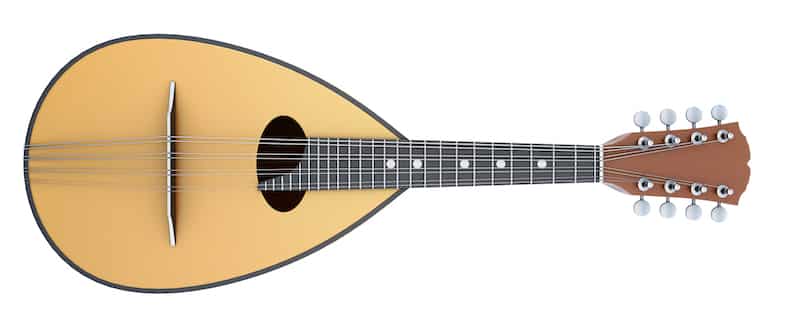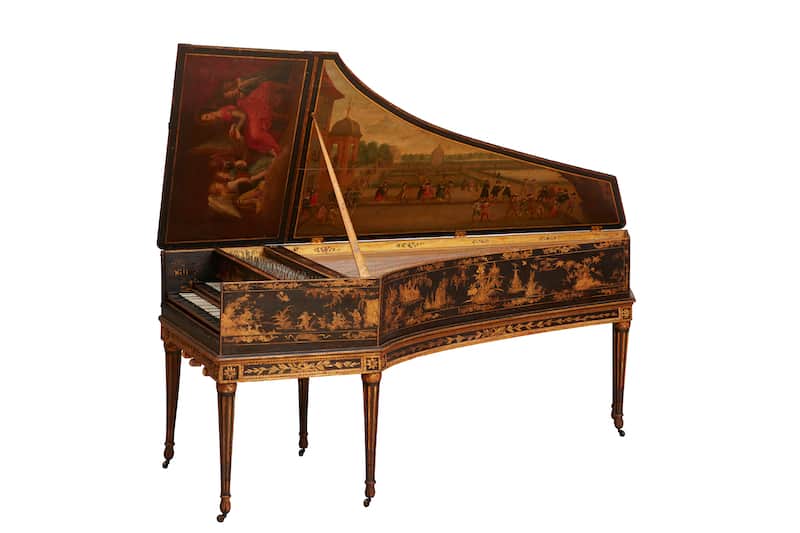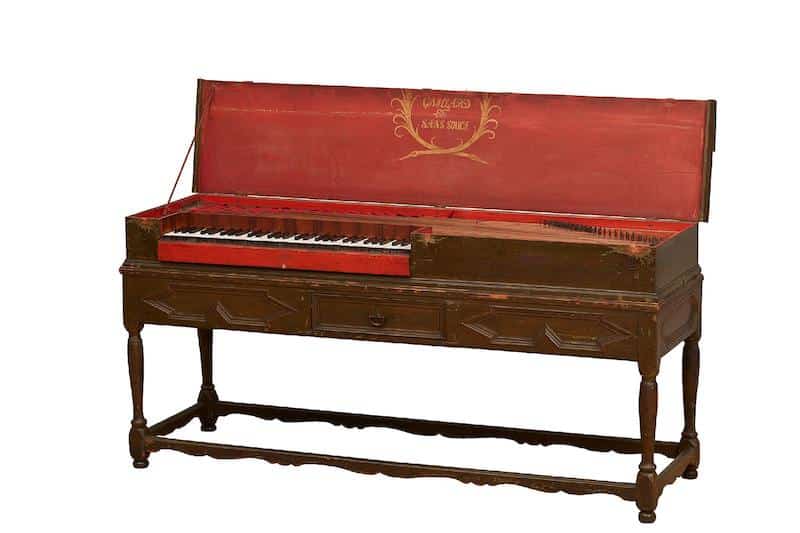Italy has had one of the most influential musical histories in the world. Besides its diverse array of folk music—made extra diverse because of its separated regions earlier in history—Italy is probably most known for its influence on Western classical music.
And on top of the musical innovations of scales, form, harmony and composers, Italy also contributed many instruments to folk and classical music. There is no shortage of interesting and influential instruments, from the famous string instruments of violin, viola, and cello to folk instruments like the torototela or ghironda.
So let’s explore some of the most common of these Italian musical instruments!
1. Zampogna
The Zampogna is a traditional Italian instrument that resembles what most Americans would call a bagpipe.
The pipes are attached to a stock which itself is attached to the large bag, traditionally made from goat hide, that the player fills with air by blowing into it.
Like the bagpipes, squeezing the air out of the bag makes a sound when moving through the pipes.
The tuning of the pipes changes according to the region it comes from and the specific music to be played.
There is also a distinction between double-reed and single-reed zampognas, with the double-reed version usually having more drones to create harmony.
2. Mandolin

The Mandolin, which evolved from the much more popular lute family of instruments, dates back to 18th century Italy.
This more modern 18th-century mandolin evolved from earlier predecessors like the madore and the gittern.
Most likely, the earlier lute instruments that would later become mandolins entered Italy from the Middle East through Sicily.
The Italian mandolin, while it does have similarities, is different in several ways from the 8-string bluegrass instrument that most people are familiar with. Also, the original mandolin had a pegboard instead of a pegbox.
3. Violin

The Violin is thought to have originated in 16th-century Italy and has grown to become one of the most popular instruments in modern classical music.
The modern violin has four strings, whereas the original versions had only three.
While the design of this modern violin was unique, it was similar to many ancestral stringed instruments like the lyre, which were plucked and bowed.
Probably the most famous Italian violin maker was Antonio Stradivari, who died in 1737 and made almost one thousand violins in his lifetime.
Professionals worldwide still play on Stradivari violins that have survived, and they are considered among the highest quality and most expensive instruments around.
4. Viola

Next, we have the Viola which is extremely similar to the violin, and it may even look like the same instrument to the untrained eye.
But a viola is larger and plays lower notes than the violin, with a one-fifth lower tuning. As such, you can consider it the alto voice in the string family.
The original Italian name for the viola was “viola de braccio,” which means “of the arm”.
The first evidence of an Italian viola comes from a famous painting in Milan during the 1530s.
Gaspare da Salo and Andrea Amati were the first two luthiers (instrument makers) that became well known for making violas in the 16th century.
5. Cello

As you can imagine, most of these string instruments are related in origin and design, with changes in size and tuning occurring over time.
This evolution explains why the Cello or more correctly the Violoncello, is the so-called tenor of the string family, gets its name from the Italian word meaning ‘small big viola‘.
Cellos, which produce a deeper and darker sound than the violin, became popular by the mid-16th century in Northern Italy.
Although he did not invent it, the already mentioned Andrea Amati also became well-known for making cellos.
By the 18th century, Stradivari standardized the size of the cello, a size that is still the norm today.
6. Double Bass

The Double Bass, the largest instrument in the string family, goes by a number of names such as the Upright Bass, Bass Fiddle, Contrabass, Stand Up Bass, or just the Bass.
Also called the “bass viol”, it is the only surviving descendant of its predecessor family of viola da gamba instruments.
But there is debate about whether the double bass evolved from the viola da gamba family of instruments or grew out of the violin family.
Either way, it was the skill of the Italian luthiers that helped make this instrument a staple of the modern orchestra.
7. Harpsichord

The concept of using a series of keys to make sound existed for a long time before the Harpsichord, with the organ. But it was the harpsichord that took this concept to a new level.
The harpsichord is a keyboard instrument that uses a mechanical quill to pluck the strings unlike the modern piano, which uses hammers to hit the strings, the plucking of a harpsichord has a distinctly metallic sound.
The earliest mention of a harpsichord comes from 1397 in Padua, a city in northern Italy. But in terms of surviving instruments, the only evidence comes from 16th-century Italy.
These early Italian harpsichords had less string tension and could not play loud or brilliantly. Later, harpsichords would increase in size, allowing for longer strings and higher tension.
8. Clavichord

It is hard to say precisely when and where the Clavichord was first invented, but it was likely in the early 14th century.
There are mentions of it throughout Germany, Italy, and England throughout the next few hundred years, and the instrument likely became more advanced in Italy.
The clavichord was particularly useful because it was portable and soft. This quiet sound production was great for practicing but too soft for performances.
So while musicians did use the clavichord throughout the renaissance and baroque periods of music, it was mainly a way for organists to practice and have rehearsal sessions.
9. Pianoforte (Piano)

The two instruments mentioned above were keyboard instruments, but they could not make loud and soft sounds and so were only able to play at one dynamic.
The name of this instrument, the PianoForte or as it’s now known the Piano, gives a clue as to why there was pressure to invent the modern piano.
“Piano” means soft in Italian, and “forte” means loud. This name made the new keyboard instrument “soft-loud.”
The original title was “gravicembalo col piano, e forte” (harpsichord with soft and loud), and they later shortened it to pianoforte.
The inventor of this new keyboard instrument, whose name they would eventually shorten to the piano, was Bartolomeo Cristofori of Northern Italy.
Cristofori invented the hammer mechanism that allowed the pianoforte to play loud and soft depending on how hard you pressed the keys.
He also redesigned the soundboard for thicker strings and higher tension—another feature that allowed the instrument to play louder.
10. Quartara
The Quartara is a particularly interesting Italian folk instrument because it looks like more of a ceramic pitcher than an instrument.
But it is a wind instrument because when you blow across the top, which has a narrow neck, it makes a sound.
Like blowing across a bottle, filling the quarata to a different amount changes the pitch.
The quartara was mainly played in southern Italy, in places like eastern Sicily and Campania.
11. Organetto
The Organetto, while it does produce sound via airflow, was not a keyboard instrument like the church organ or chamber organ.
The organetto was an accordion-like instrument with buttons instead of keys. It is also called a Melodeon or a Diatonic Button Accordion.
Unlike a chromatic keyboard instrument that can play every musical pitch, the diatonic button organetto could only play in one key/scale at a time.
This diatonic model of the accordion was more popular in central Italy, and accordions with chromatic capabilities were more prolific in northern Italy.
12. Torototela
Music historians do not know much about the Torototela, a fiddle instrument that bows to make a sound.
But unlike the other popular string instruments made popular in Italy, the torototela only had one string.
With only one string, making drone sounds like on the zampogna or ghironda was impossible.
The torototela was most popular in northeast Italy.
13. Ghironda (Hurdy-Gurdy)
The Ghironda is an Italian folk instrument with the English name of the Hurdy-Gurdy.
It is technically a string instrument that uses a bow to make sound, but it does not do so in the traditional way that a violin would.
The ghironda instead has a hand crank on the side attached to a wheel with rosin on it, producing sound when it moves across the strings.
Like lots of folk music, the ghironda includes multiple drone strings that sound the same pitch underneath whatever melody the player makes on the keyboard section.
These drone sounds make the ghironda similar in sound to the zampogna, which like bagpipes, relies on drones to capture the intense sound.
This instrument is popular in northern regions of Italy like Lombardy, Emilia, and Piedmont.
Summing up our List of Italian Instruments
As you can see, Italy has so many instruments that either influenced modern instruments or were inventions of instruments still in use today.
Modern instruments like the violin or piano are so prolific that it can be easy to forget when and where they began.
But Italian instrument makers, like Bartolomeo Cristofori and Antonio Stradivari, made invaluable contributions to modern music sounds.
Hopefully, you now have a greater understanding of Italy’s rich musical history and its large amount of musical instruments.
